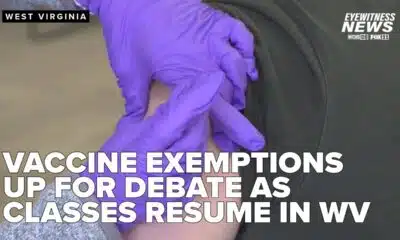News from the South - West Virginia News Feed
Technologists welcome executive order on AI in schools but say more detail is needed
by Paige Gross, West Virginia Watch
May 2, 2025
Education software experts say they’re cautiously optimistic about a Trump administration drive to incorporate AI into classrooms, but such a program needs clear goals, specific rules — and enough money to fund the costly systems.
“AI is, inherently, really expensive,” said Ryan Trattner, CEO of AI-assisted studying tool Study Fetch. “It’s not something that scales like a normal piece of software where it might be the same price for 1,000 people to use it as 100,000.”
Among a handful of education-related executive orders last week, President Donald Trump released an order to incorporate artificial intelligence education, training and literacy in K-12 schools for both students and teachers.
The move is in line with other actions Trump has taken to promote quick growth of artificial intelligence in the U.S., including rolling back the 2023 Biden administration executive order that aimed to promote competition within the AI industry while creating guidelines for responsible government use of the technology. Introducing AI to grade school children is meant to create an “AI-ready workforce and the next generation of American AI innovators,” the order said.
A task force made up of members from various federal departments — like the Departments of Agriculture, Education, Energy and Labor, as well as the directors of the Office of Science and Technology Policy, the National Science Foundation and other federal agency representatives — will be developing the program over the next 120 days.
Some makers of AI tools for students said they are cautiously optimistic about more widespread use of AI in schools, saying it would better prepare kids for the current workforce. But they say success with this program hinges on the ability to measure outcomes for AI learning, an understanding of how AI plays a role in society and a set of clear federal guidelines around AI, which the U.S. does not currently have.
Many students, parents and teachers are already using AI in some portion of their learning, often through AI-powered tutoring, counseling, training, studying or tracking tools mostly available from private companies.
Bill Salak, chief technology officer at AI learning and studying platform Brainly, said that many AI tools built for education right now aim to fill gaps in schools where teachers are often spread thin. They may be using AI tools to help them make lesson plans, presentations or study guides. Brainly was founded on the idea of simulating student-run study groups, and is a supplement to classroom learning, Salak said.
Salak is happy to see an initiative that will prompt educators to incorporate AI literacy in schools, saying he feels we’re in a “rapidly changing world” that requires much of the workforce to have a baseline understanding of AI. But he says he hopes the task force gets specific about their goals, and develops the ability to measure outcomes.
“I do think there will be further mandates needed, especially one in which we revisit again, like, what are we teaching?” he said. “What are the standards that we’re holding our teachers to in terms of outcomes in the classroom?”
Specific objectives may come after the 120 day research period, but the executive order currently says that the initiative will develop online resources focused on teaching K-12 students foundational AI literacy and critical thinking skills, and identify ways for teachers to reduce time-intensive administrative tasks, improve evaluations and effectively teach AI in computer science and other classes. It also seeks to establish more AI-related apprenticeship programs targeted at young people.
Trattner of Study Fetch said he’s eager to see a green light from the administration for schools to invest in AI education. The Study Fetch platform allows students and teachers to upload course material from a class, and receive customized studying materials. Trattner said that initially many educators were worried that AI would allow students to cheat, or get through classes without actually learning the material.
But he said in the last year or so, teachers are finding specific tasks that AI can help alleviate from their long to-do lists. Generative AI chatbots are probably not the best fit for classrooms, but specific AI tools, like platforms that help students learn their curriculum material in personalized ways, could be.
“Everybody knows this, but teachers are extremely overworked, with multiple classes,” Trattner said. “I think AI can definitely help educators be substantially more productive.”
But cost is something the committee should consider, Trattner said. The executive order calls for the development of public-private partnerships, and said the committee may be able to tap discretionary grant funding earmarked for education, but it didn’t outline a budget for this initiative. AI tools are often more expensive than other software that schools may be used to buying in bulk, Trattner said.
Some AI tools are targeted toward other parts of the school experience, like College Guidance Network’s Eva, an AI counseling assistant that helps users through the college application process, and helps parents with social and emotional dynamics with their children.
Founder and CEO Jon Carson said he’s not sure that this executive order will make a big impact on schools, because schools tend to follow state or local directives. He also feels like the current administration has damaged its authority on K-12 issues by attempting to shut down the Department of Education.
“In another era, we might actually even bring it up if we were talking to a school district,” Carson said. “But I don’t think we would bring this up, because the administration has lost a lot of credibility.”
Carson hopes the committee plans for security and privacy policies around AI in schools, and folds those principles into the curriculum. Federal guidance on AI privacy could help shape everyone’s use, but especially students who are at the beginning of their experience with the technology, he said.
A successful version of this program would teach students not just how to interact with AI tools, but how they’re built, how they process information, and how to think critically about the results they receive, Salak said. Educators have a right to be critical of AI, and the accuracy of information it provides, he said. But critical thinking and validating information is a skill everyone needs, whether the information comes from a textbook or an algorithm.
“In a world where there’s so much information readily accessible and misinformation that is so readily accessible, learning early on how to question what it is that AI is saying isn’t a bad thing,” Salak said. “And so it doesn’t need to be 100% accurate. But we need to develop skills in our students to be able to think critically and question what it’s saying.”
The specific recommendations and programing stemming from the Artificial Intelligence Education Task Force likely won’t come until next school year, but Salak said he feels the U.S. workforce has been behind on AI for a while.
“I really hope that we’re able to overhaul the agility at which the education institution in America changes and adapts,” Salak said. “Because the world is changing and adapting very, very fast, and we can’t afford to have an education system that lags this far behind.”
West Virginia Watch is part of States Newsroom, a nonprofit news network supported by grants and a coalition of donors as a 501c(3) public charity. West Virginia Watch maintains editorial independence. Contact Editor Leann Ray for questions: info@westvirginiawatch.com.
The post Technologists welcome executive order on AI in schools but say more detail is needed appeared first on westvirginiawatch.com
Note: The following A.I. based commentary is not part of the original article, reproduced above, but is offered in the hopes that it will promote greater media literacy and critical thinking, by making any potential bias more visible to the reader –Staff Editor.
Political Bias Rating: Centrist
The article provides a neutral, factual report on the executive order introduced by the Trump administration regarding the incorporation of AI in schools. It focuses on the perspectives of technologists, educators, and experts about the potential benefits and challenges of AI in education. The language is measured and descriptive, presenting the views of various stakeholders, including cautious optimism and concerns about cost and implementation. There is no overt endorsement of any political ideology or clear slant toward either side of the political spectrum. While some opinions are expressed about the Trump administration’s actions, these are attributed to the individuals quoted and not presented as the article’s own perspective. The overall tone remains balanced, offering insight into both support and skepticism without pushing a particular agenda.
News from the South - West Virginia News Feed
WEEKEND WEATHER AUG 24TH
SUMMARY: WEEKEND WEATHER AUG 24TH: Today was a pleasant, typical summer day with temperatures reaching 80° in Beckley. A cold front is moving through tonight, bringing increasingly breezy winds and cooler air, dropping temps to the high 50s overnight and into the 40s early next week. Rain chances remain very low, with mainly dry conditions expected tonight and tomorrow. Monday will feature a mix of clouds and sun with highs in the high 60s to low 70s—cooler than normal. Low humidity and comfortable weather will continue through the week, making it a great time to enjoy the outdoors as fall arrives early.
FOLLOW US ON FACEBOOK AND TWITTER:
https://facebook.com/WOAYNewsWatch
https://twitter.com/WOAYNewsWatch
News from the South - West Virginia News Feed
Feds direct states to check immigration status of their Medicaid enrollees
by Anna Claire Vollers, West Virginia Watch
August 22, 2025
This week, the Trump administration’s Centers for Medicare & Medicaid Services (CMS) announced an effort to check the immigration status of people who get their health insurance through Medicaid and the Children’s Health Insurance Program.
Medicaid is the public health insurance program for people with low incomes that’s jointly funded by states and the federal government. For families that earn too much to qualify for Medicaid but not enough to afford private insurance, CHIP is a public program that provides low-cost health coverage for their children.
The feds will begin sending states monthly enrollment reports that identify people with Medicaid or CHIP whose immigration or citizenship status can’t be confirmed through federal databases. States are then responsible for verifying the citizenship or immigration status of individuals in those reports. States are expected to take “appropriate actions when necessary, including adjusting coverage or enforcing non-citizen eligibility rules,” according to a CMS press release.
“We are tightening oversight of enrollment to safeguard taxpayer dollars and guarantee that these vital programs serve only those who are truly eligible under the law,” Robert F. Kennedy Jr., who oversees CMS as secretary of the U.S. Department of Health and Human Services, said in a press release announcing the new program.
As of April, roughly 71 million adults and children nationwide have Medicaid coverage, while another 7 million children have insurance through CHIP. Immigrants under age 65 are less likely to be covered by Medicaid than U.S.-born citizens, according to an analysis from health research organization KFF.
Immigrants who are in the country illegally aren’t eligible for federally funded Medicaid and CHIP. Only citizens and certain lawfully present immigrants — green card holders and refugees, for example — can qualify.
But some states have chosen to expand Medicaid coverage for immigrants with their own funds. Twenty-three states offer pregnancy-related care regardless of citizenship or immigration status, according to KFF. Fourteen states provide coverage for children in low-income families regardless of immigration status, while seven states offer coverage to some adults regardless of status.
The tax and spending package President Donald Trump last month cuts federal spending on Medicaid by more than $1 trillion, leaving states to either make up the difference with their own funds or reduce coverage. But the new law also includes restrictions on coverage for certain immigrants, including stripping eligibility from refugees and asylum-seekers.
Stateline reporter Anna Claire Vollers can be reached at avollers@stateline.org.
West Virginia Watch is part of States Newsroom, a nonprofit news network supported by grants and a coalition of donors as a 501c(3) public charity. West Virginia Watch maintains editorial independence. Contact Editor Leann Ray for questions: info@westvirginiawatch.com.
The post Feds direct states to check immigration status of their Medicaid enrollees appeared first on westvirginiawatch.com
Note: The following A.I. based commentary is not part of the original article, reproduced above, but is offered in the hopes that it will promote greater media literacy and critical thinking, by making any potential bias more visible to the reader –Staff Editor.
Political Bias Rating: Centrist
This article provides a balanced overview of recent policy changes to Medicaid and CHIP enrollment verification tied to immigration status. It presents facts, official statements, and statistics without emotive language or partisan framing. Both the rationale behind the policy, such as safeguarding taxpayer dollars, and the impact on immigrants are covered objectively. The inclusion of context on eligibility rules and varying state approaches reinforces a neutral, informative tone, typical of centrist reporting seeking to inform rather than advocate.
News from the South - West Virginia News Feed
Students go back to school in West Virginia, but same education debates rage
by Andrew Donaldson, West Virginia Watch
August 21, 2025
While students across the Mountain State are going back to school to advance to the next grade, many parents and most of the politicians seemed to be held back in the same spots with the same education arguments of the last few years.
News headlines and social media stories come one at a time on the as-needed basis as events and the business model dictate. But separate news items and viral debates over school choice, school funding, school vaccination requirements, school closings, school performance, and school staffing are variations on one theme: What is education, and who should control it?
That basic “who/what” question of intent and control is not unique to education issues. All political stories when reduced to their essences are stories about power and money. Education has become more and more a political endeavour, because of inherently involved power and money. As such, the rules of discerning politics apply far more than the traditional policy ideas and learning philosophies of what information goes into a student and how to evaluate the information coming out of a student. Add in the culture warring elements fueled by the modern marriage of news media and social media, and you have an environment that is heavy on the vibes and light on vocation.
The COVID-19 crisis is justifiably noted to be an inflection point in the push-pull world of policy and politics in general and education specifically. COVID — or more specifically the reaction by the people involved in running the institutions of American society from schools, to government, to health care, to social order — revealed the pre-existing flaws with a stress test that most everyone failed to one degree or another. While the high-minded ideals of learning, education and bettering the next generation were still recited as if the words themselves would magically manifest such things into malleable minds, reality told a different story.
Schools were closed, opened, closed again, re-opened with restrictions and not-ready-for-prime-time hybrid and online learning. Exceptions and standards had to be adjusted on the fly. Parents and the government had a tug-of-war over who could better understand an unprecedented crisis in public health and public trust with in-classroom teachers and their students as the rope.
The generation of students who lived through it heard all the buzzwords and platitudes, but weighed them against their lived experience, and found them wanting. Words said education matters, students matter, learning matters. Actions told them the priority of the education system was to be a giant jobs and funding program first, a daycare for parents second, and once that was all satisfied, perhaps you might learn something while being taught to pass a test to show what you learned.
Post-COVID, plenty of parents and politicians seem unable to let go of the tug-of-war rope. While the individual debates over issues like the vaccine exemptions, the ballooning cost of the Hope Scholarship, and debates over what should and shouldn’t be included in curriculum continue, perspective is badly needed that all these threads form the one cord of systematically educating students. The in-classroom teachers and students are on a treadmill that starts every August and keeps going until the following June. Education in the United States of America in the Year of Our Lord 2025 is very much a machine that does not stop.
The ever-entwined socio-political news and social media coverage of education runs at variable speeds, mostly parallel to the actual in-classroom education system. When the news narratives and social media attention does cross over into the real world education system, chaos and confusion are usually the result. Regardless of the chaos or the reason du jour, the in-classroom teachers have to press ahead with the students. While the algorithms and consultants keep us entertained, the pressure on an already overworked, underfunded and constantly criticized in-classroom environment is doing no one any favors.
Not that there ever was an era of magnanimous politics, but even with cellphones being banned from classrooms the rising generations of students have more information on current events than ever before. Those students aren’t just learning the curriculum; they are learning what the adults — teachers, parents, government officials, administrators — really think about them and their place in the education and political machines that drive America. And they are going to believe us.
GET THE MORNING HEADLINES.
West Virginia Watch is part of States Newsroom, a nonprofit news network supported by grants and a coalition of donors as a 501c(3) public charity. West Virginia Watch maintains editorial independence. Contact Editor Leann Ray for questions: info@westvirginiawatch.com.
The post Students go back to school in West Virginia, but same education debates rage appeared first on westvirginiawatch.com
Note: The following A.I. based commentary is not part of the original article, reproduced above, but is offered in the hopes that it will promote greater media literacy and critical thinking, by making any potential bias more visible to the reader –Staff Editor.
Political Bias Rating: Center-Left
The content presents a critical view of the current education system, highlighting systemic issues such as underfunding, politicization, and the impact of COVID-19 on schooling. It emphasizes the struggles of teachers and students within a politicized environment and calls for broader perspective and reform. While it critiques both political sides and the media’s role, the focus on social challenges and institutional shortcomings aligns more closely with center-left perspectives that advocate for systemic improvements and greater support for public education.
-
News from the South - West Virginia News Feed7 days ago
Religious exemption debate front and center amid new school year in WV
-
News from the South - Arkansas News Feed7 days ago
Trump, Zelenskyy exit White House talks hopeful about security guarantee for Ukraine
-
News from the South - Alabama News Feed6 days ago
U.S. agriculture secretary announces end to subsidies for solar panels on farmland
-
News from the South - Alabama News Feed7 days ago
Despite federal shift, state health officials encourage COVID vaccines for pregnant women
-
News from the South - Tennessee News Feed7 days ago
Push to eliminate sugar from SNAP plan
-
News from the South - Kentucky News Feed5 days ago
First of its kind clinical trial offers new hope for Kentuckians at risk of dementia
-
News from the South - West Virginia News Feed6 days ago
Free AI testing platform rolled out to federal employees
-
News from the South - Virginia News Feed7 days ago
Low 80s and winds possible from Hurricane Erin








































